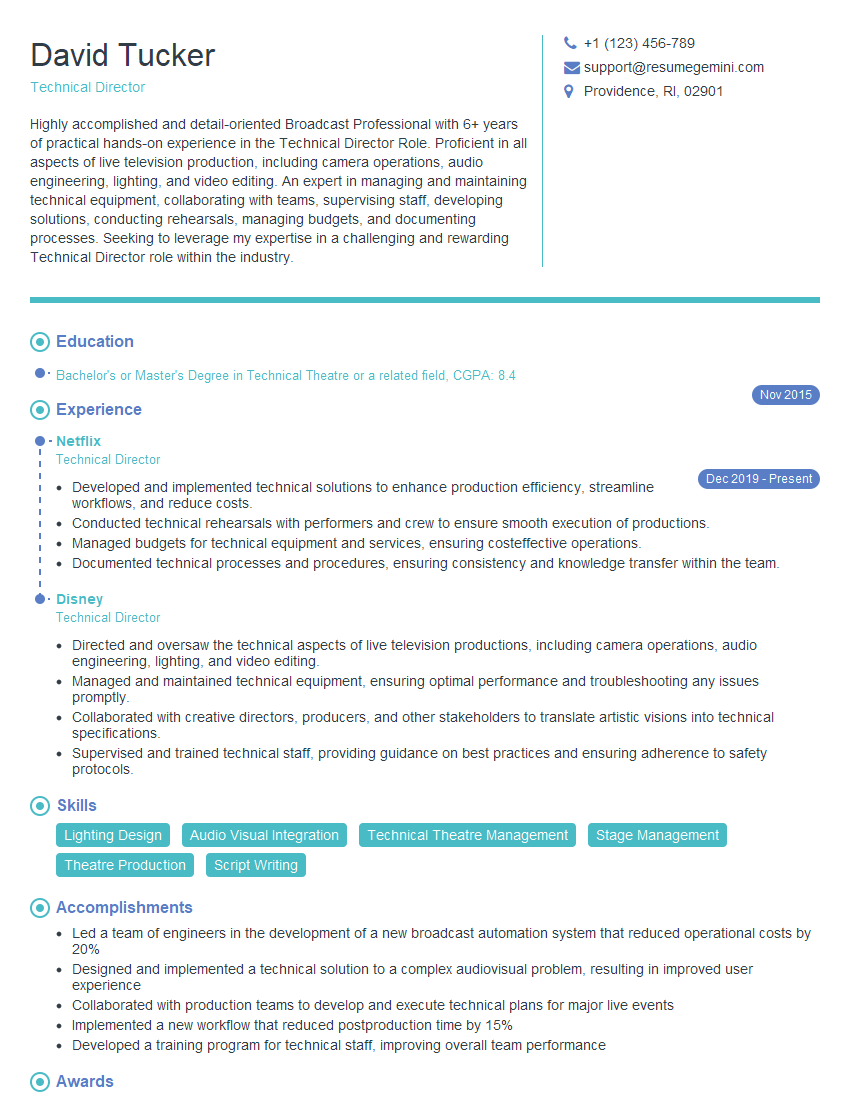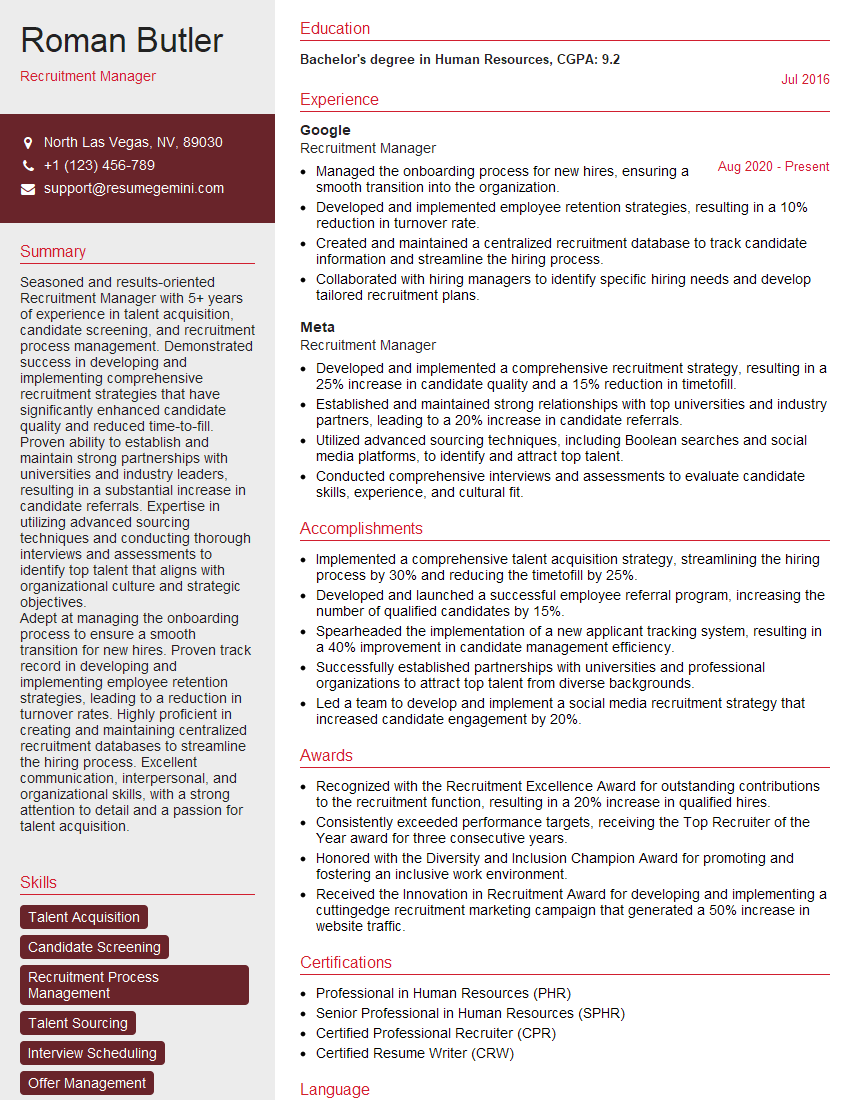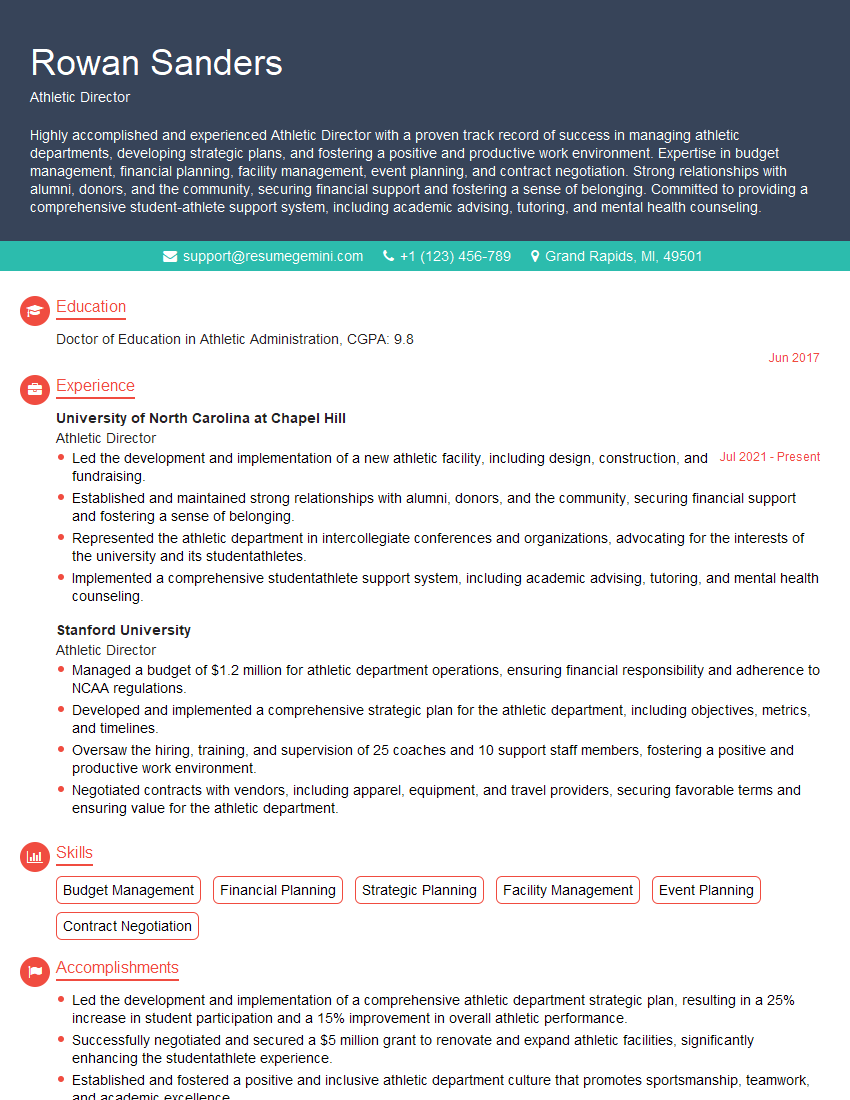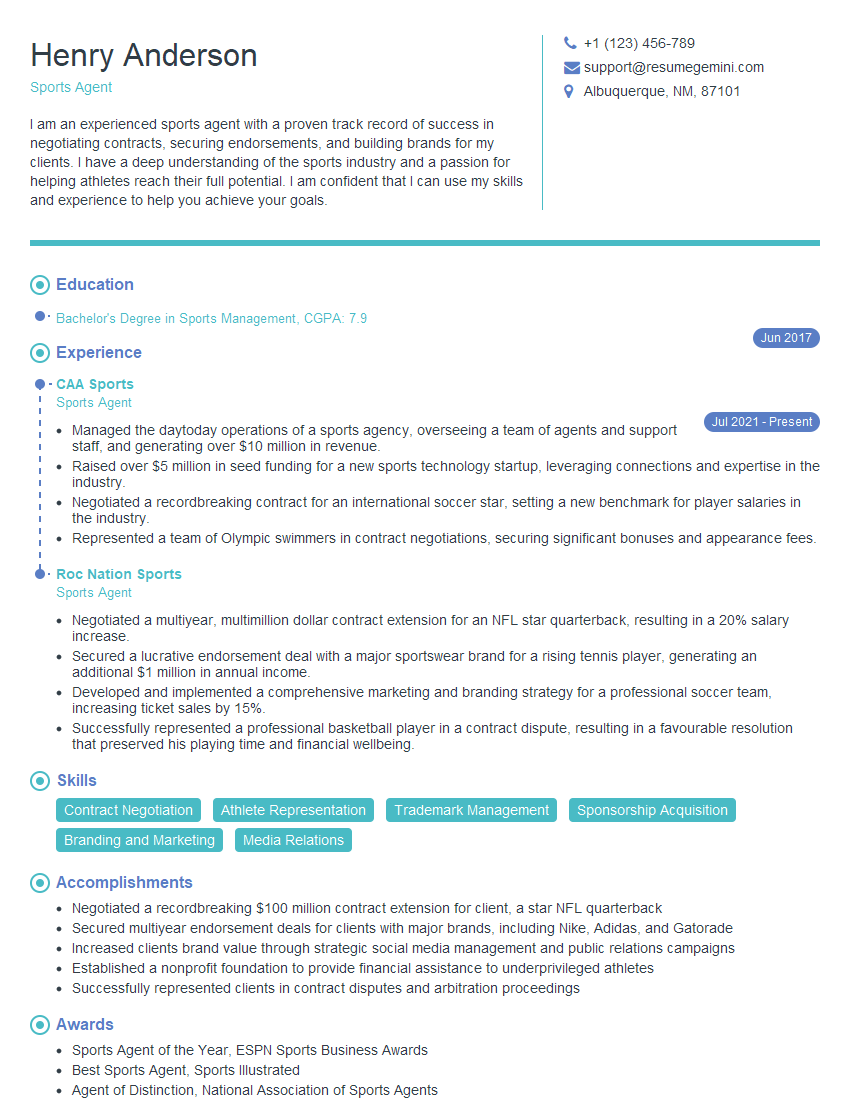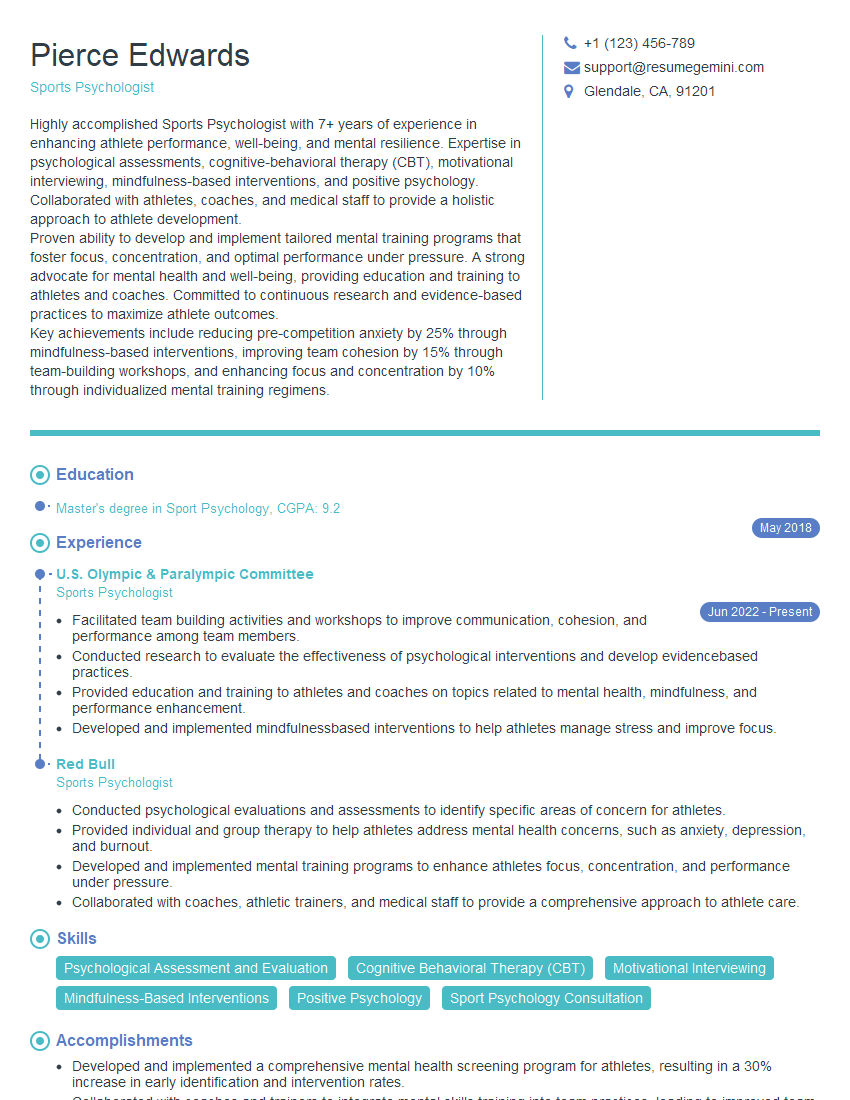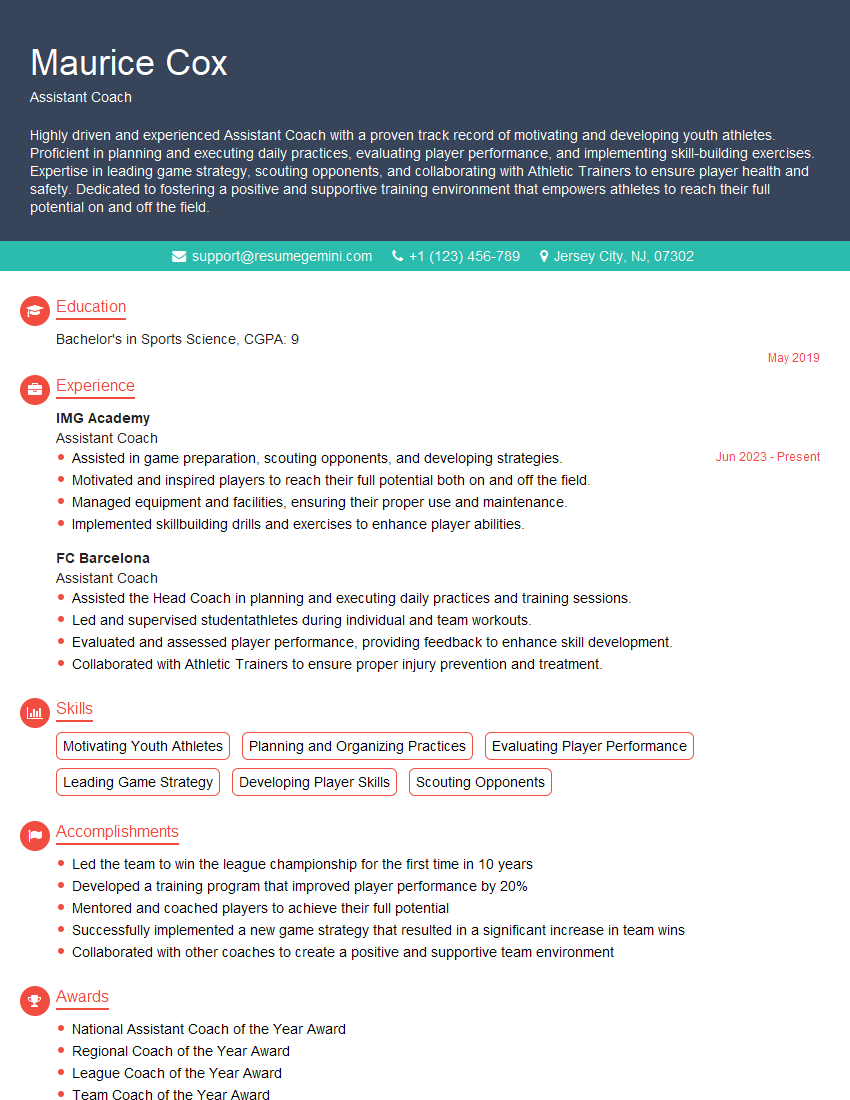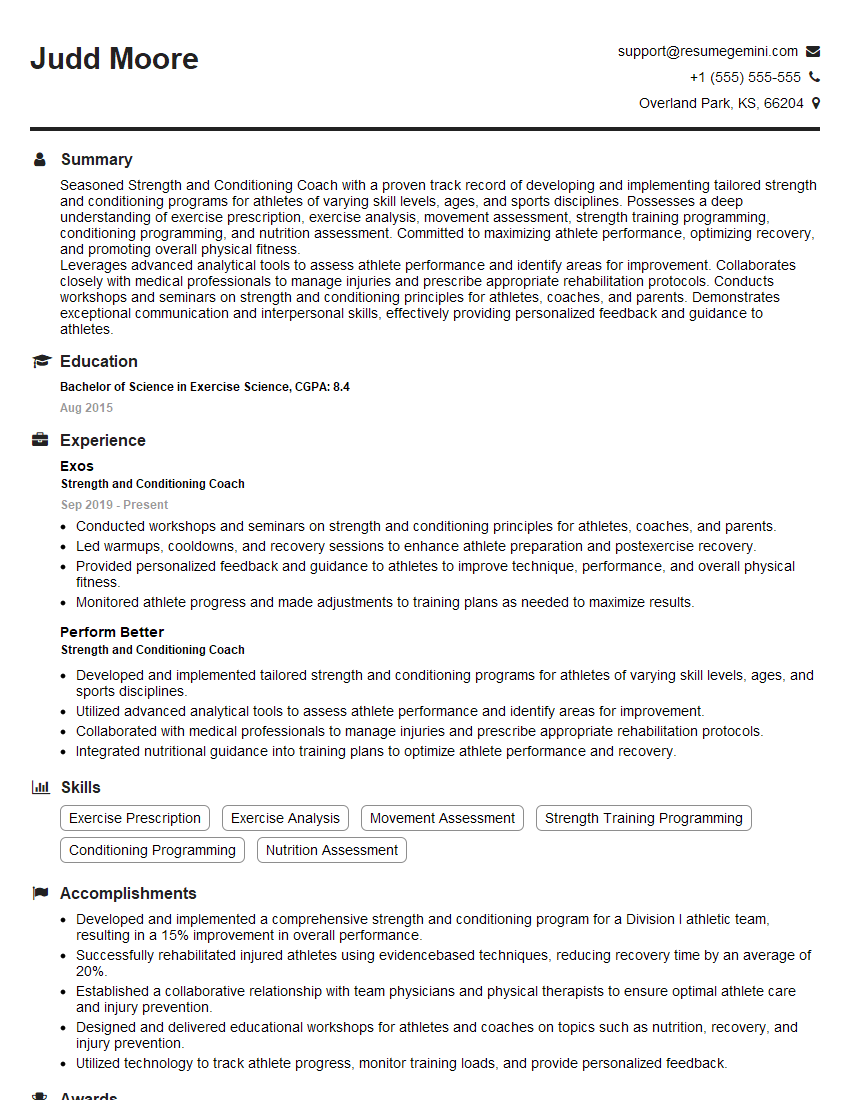The right preparation can turn an interview into an opportunity to showcase your expertise. This guide to Interviewing Players and Coaches interview questions is your ultimate resource, providing key insights and tips to help you ace your responses and stand out as a top candidate.
Questions Asked in Interviewing Players and Coaches Interview
Q 1. Describe your process for assessing a player’s technical skills.
Assessing a player’s technical skills involves a multi-faceted approach focusing on the fundamental aspects of their chosen sport. It’s not just about raw talent, but also about consistency, efficiency, and adaptability.
- First Impressions: I begin by observing the player in a game or training environment, noting their first touch, passing accuracy, shooting technique, dribbling skills, and overall control of the ball (or puck, bat, etc., depending on the sport).
- Specific Drills and Exercises: Structured drills are crucial. I’ll design exercises that isolate specific skills, such as short passing accuracy under pressure, long-range shooting, or defensive footwork. This allows for precise measurement and identification of strengths and weaknesses.
- Game-Specific Situations: Technical skill isn’t just about individual execution; it’s about performing under pressure. I’ll observe how players handle the ball in 1v1 situations, their ability to execute skills under pressure from opponents, and their decision-making under duress.
- Data Analysis (if available): In modern sports, data analysis plays a key role. Stats like pass completion percentage, shots on target, and even speed and agility metrics help provide quantitative data to supplement qualitative observations.
For example, I might observe a young footballer’s passing accuracy – is it consistently high, or does it drop significantly under pressure? This helps determine their overall technical proficiency and areas for improvement.
Q 2. How do you evaluate a player’s tactical awareness?
Evaluating tactical awareness goes beyond simply understanding the rules; it’s about a player’s ability to read the game, anticipate opponent movements, and make smart decisions on the field (or court, etc.).
- Game Observation: I watch how players position themselves on the field, their decision-making in possession and without, and their reaction to changing game situations. Do they understand spatial awareness and make intelligent runs? Do they identify and exploit weaknesses in the opponent’s formation?
- Hypothetical Scenarios: I might present players with hypothetical scenarios during interviews or coaching sessions, asking them how they would react in specific game situations. This helps me assess their understanding of tactical principles and problem-solving abilities.
- Post-Game Analysis: Discussing the game afterwards can be very revealing. Asking about their decision-making process for particular plays provides valuable insights into their understanding of the tactical flow of the game.
- Team Play: I evaluate how effectively they work within a team structure, understanding their roles and responsibilities and reacting accordingly to their teammates’ actions.
Imagine a basketball player who consistently anticipates the opponent’s passing lanes and intercepts passes. This demonstrates high tactical awareness and game intelligence.
Q 3. What methods do you use to assess a player’s mental fortitude?
Assessing mental fortitude requires going beyond simple skill evaluation; it’s about understanding a player’s resilience, determination, and ability to cope with pressure. This is often the most challenging aspect to evaluate.
- Observation during High-Pressure Situations: Games are the best environment to assess this. How do they perform during crucial moments? Do they remain calm and composed under pressure, or do they crumble?
- Interviews and Conversations: Open-ended questions can be very effective. Discussing previous setbacks, challenges, and how they overcame them provides crucial insights into their mental resilience.
- Body Language and Demeanor: Subtle cues during training or games can be just as revealing as their performance. Do they exhibit confidence, determination, or signs of frustration or self-doubt?
- Psychological Tests (in certain contexts): In professional settings, psychological assessments may be used to gain a deeper understanding of a player’s mental attributes, but these are less common for amateur or youth levels.
A player’s response to a missed crucial penalty or a critical error in a championship game speaks volumes about their mental fortitude. Do they bounce back and continue to contribute, or do they let the error affect their subsequent play?
Q 4. How do you identify potential in a young player?
Identifying potential in young players requires a keen eye for raw talent, coachability, and physical attributes, understanding that potential isn’t always immediately obvious.
- Physical Attributes: Natural athleticism – speed, agility, coordination – forms a strong foundation. While these can be developed, a strong base is a clear advantage.
- Technical Foundation: While not necessarily polished, the presence of natural aptitude for technical skills shows potential. A player might have a raw but promising shooting technique, for example.
- Coachability and Work Ethic: A player’s willingness to learn, adapt, and work hard is crucial. This often outweighs raw talent alone.
- Mental Attitude: A positive, determined mindset and a growth-oriented approach contribute significantly to a player’s potential for future development.
- Long-term Projection: Consider the player’s age and stage of development. Projecting their potential based on their current trajectory requires considering their growth potential over several years.
I once saw a young basketball player with exceptional height but initially poor ball-handling skills. However, his work ethic and dedication were evident. With coaching, he developed into a key player, showcasing that potential isn’t always immediately apparent.
Q 5. Explain your approach to evaluating a coach’s leadership style.
Evaluating a coach’s leadership style involves observing how they interact with players, staff, and other stakeholders. It’s about more than just wins and losses; it’s about their approach to team building and player development.
- Observational Methods: I attend practices and games, noting their interactions with players. Are they supportive, demanding, or a blend of both? Do they foster a positive team environment?
- Interviews and Feedback: I’ll speak with players and staff about their experiences with the coach. This provides vital firsthand perspectives on their leadership qualities, communication effectiveness, and overall impact.
- Team Dynamics: Is there a positive team culture? A strong team environment often reflects effective leadership. Look at how well the team performs under pressure and handles adversity.
- Decision-Making: How does the coach make crucial decisions? Are they strategic and decisive? Do they learn from their mistakes?
For instance, a coach who consistently praises effort and improvement, while also providing constructive criticism, displays a positive and effective leadership style.
Q 6. How do you assess a coach’s tactical and strategic capabilities?
Assessing a coach’s tactical and strategic capabilities requires a detailed analysis of their game plans, in-game adjustments, and overall team performance.
- Game Analysis: I thoroughly analyze their game plans before, during, and after matches. Do they adapt their strategies based on opponent strengths and weaknesses? Do they implement effective set plays and formations?
- Player Utilization: How effectively do they utilize their players’ strengths and compensate for their weaknesses? Do they make the right substitutions at the right times?
- In-Game Adjustments: How well do they react to unexpected changes in the game? Do they make timely and effective adjustments to their strategy to counter opponent moves?
- Long-Term Vision: Beyond the immediate game, do they have a clear long-term vision for the team’s development and style of play?
A coach who demonstrates a deep understanding of their opponent’s style and strategically counters their strengths while exploiting their weaknesses would be considered tactically astute.
Q 7. What are your key criteria for evaluating a coach’s communication skills?
Effective communication is fundamental to a coach’s success. It involves clear and concise messaging, active listening, and the ability to connect with individuals at different levels.
- Clarity and Conciseness: Do they deliver messages effectively? Are their instructions clear and easily understood by players of varying skill levels?
- Active Listening: Do they genuinely listen to player feedback, concerns, and suggestions? Are players comfortable communicating with the coach?
- Non-Verbal Communication: Body language plays a big role. Does the coach’s body language convey confidence, encouragement, or frustration?
- Adaptability: Can they adapt their communication style to different individuals and situations? Are they able to deliver both positive reinforcement and constructive criticism effectively?
A coach who can effectively communicate complex tactical instructions in a simple and understandable way, and also foster open communication within the team, exhibits strong communication skills.
Q 8. How do you gauge a coach’s ability to manage a team’s dynamics?
Gauging a coach’s ability to manage team dynamics goes beyond simply observing practices. It requires a nuanced understanding of leadership styles, communication skills, and conflict resolution techniques. I assess this through a combination of methods.
Behavioral Questions: I pose open-ended questions like, “Describe a time you had to address a conflict within your team.” The answer reveals their approach to conflict—are they collaborative, authoritative, or avoidant? A good response would showcase empathy, active listening, and a focus on finding solutions that benefit the team as a whole.
Scenario-Based Questions: Presenting hypothetical scenarios, like a player struggling with performance or interpersonal issues, allows me to evaluate their problem-solving skills and their ability to tailor their approach to individual players. For instance, I might ask: “How would you handle a situation where a star player is underperforming and impacting team morale?”
Reference Checks: Speaking with previous players or staff members provides invaluable insights into their interpersonal style and ability to foster a positive team environment. I specifically ask about instances where the coach had to deal with difficult personalities or challenging situations.
Observational Analysis (if possible): Directly observing a coaching session or team meeting allows for a firsthand assessment of their communication style, ability to motivate players, and how they handle team dynamics in real-time.
Ultimately, I’m looking for evidence of strong communication, empathy, fairness, and the ability to build a cohesive and supportive team environment.
Q 9. Describe your experience in conducting structured interviews with athletes.
My experience with structured athlete interviews spans over 15 years, encompassing various sports and levels of competition. I’ve interviewed athletes ranging from high school recruits to professional players. My approach centers around a detailed interview guide tailored to the specific position and sport. This guide includes a mix of:
Behavioral Questions: These explore past experiences to predict future performance. For example, “Tell me about a time you faced a setback. How did you overcome it?” This reveals resilience and problem-solving abilities.
Technical Questions: These assess their understanding of the sport’s technical aspects. For a basketball player, this might include questions about offensive strategies or defensive schemes. These questions should be specific to the player’s position.
Situational Questions: These assess how the athlete would react under pressure. For example, “Imagine you’re down by one point in the final seconds. Describe your approach.”
Personality Questions: These gauge their personality traits and how they might fit into the team culture. Questions can address teamwork, leadership styles, and how they handle pressure.
I always ensure the interview is conversational, allowing the athlete to express themselves openly while maintaining a structured flow. I carefully document their responses and use a rubric to objectively assess their answers based on pre-defined criteria.
Q 10. What are some common biases to avoid during player interviews?
Avoiding bias during player interviews is crucial for fairness and accuracy. Some common biases to watch out for include:
Confirmation Bias: This involves seeking out information that confirms pre-existing beliefs. To combat this, I consciously challenge my assumptions and actively look for evidence that contradicts my initial impressions.
Halo Effect: This is the tendency to let one positive trait influence overall judgment. For instance, a player’s excellent physical skills might overshadow potential weaknesses in their character or work ethic. I actively evaluate each aspect independently.
Anchoring Bias: This occurs when the first piece of information significantly influences subsequent judgments. I avoid revealing my initial impressions or expectations to ensure the interview progresses objectively. I also vary the order of questions to minimize the impact of early answers.
Similarity Bias: This is the unconscious preference for candidates who resemble the interviewer. I focus on objective criteria and standardized evaluation metrics to mitigate this bias.
Using structured interviews with predetermined questions and a scoring system helps to minimize the impact of these biases.
Q 11. How do you ensure fairness and objectivity during the interview process?
Ensuring fairness and objectivity is paramount. I achieve this through several key strategies:
Standardized Interview Process: Every candidate receives the same questions in a consistent format. This removes potential inconsistencies that can arise from ad-hoc questioning.
Pre-defined Rating Scales: I use clearly defined rating scales for each question, allowing for objective scoring. This minimizes subjectivity and allows for easy comparison between candidates.
Multiple Interviewers: Involving multiple interviewers helps to cross-check observations and reduce individual biases. We compare notes and collectively arrive at a consensus.
Blind Review (where feasible): Removing identifying information like names and team affiliations from applications before initial screening can mitigate unconscious biases.
Detailed Documentation: Meticulous record-keeping of the interview process, including questions, responses, and scores, ensures transparency and accountability.
By implementing these measures, I strive to create a level playing field for all candidates, ensuring a fair and objective evaluation.
Q 12. What techniques do you employ to put players at ease during interviews?
Putting players at ease is crucial for obtaining honest and comprehensive responses. I employ several techniques:
Building Rapport: I begin with informal conversation to create a comfortable atmosphere. Starting with light questions about their background or interests helps break the ice.
Active Listening: Demonstrating genuine interest in what they have to say builds trust and encourages open communication. I use verbal and non-verbal cues to show I’m actively engaged.
Positive Body Language: Maintaining open and approachable body language—like maintaining eye contact and nodding—demonstrates attentiveness and creates a welcoming environment.
Clear and Concise Questions: Avoiding jargon and using clear, simple language makes the interview less intimidating and allows for more straightforward responses.
Control the Environment: Choosing a quiet, private setting free from distractions minimizes anxiety and allows for a focused conversation.
By creating a relaxed and trusting environment, I encourage open communication and more truthful responses.
Q 13. How do you handle situations where a player is evasive or dishonest during an interview?
Handling evasiveness or dishonesty requires tact and careful observation. I don’t directly accuse, but instead employ strategies to gently probe for more information:
Reframing Questions: Rephrasing a question from a different angle can help elicit a more direct response. For example, instead of asking “Did you break team rules?”, I might ask “What are some challenges you faced during the season and how did you manage them?”
Follow-up Questions: Asking probing follow-up questions based on previous answers can help reveal inconsistencies or contradictions. This shows that I’m carefully evaluating their responses.
Observational Clues: Non-verbal cues like body language, hesitation, or inconsistencies in their story can be revealing. I pay close attention to these factors.
Reference Checks: Verifying information with other sources, like coaches or teammates, can provide additional context and corroboration.
If dishonesty is confirmed, it’s important to document the incident clearly and address it according to established guidelines. The goal isn’t to judge but to gather accurate information and make informed decisions.
Q 14. How do you assess a player’s physical fitness level beyond standard testing?
Assessing physical fitness beyond standard testing involves a holistic approach that considers various factors:
Observation During Training: Observing the athlete’s work ethic, intensity, and overall performance during training sessions provides insights into their physical capabilities and resilience.
Movement Analysis: Evaluating their movement patterns, flexibility, balance, and coordination can reveal potential weaknesses or areas for improvement. This may involve simple observation or more specialized movement screens.
Injury History: Understanding their injury history and recovery process reveals their capacity to handle physical demands and their overall durability. This also shows their proactive approach to health.
Self-Reported Data: Collecting information about their training regimen, sleep patterns, and nutrition habits can provide further context regarding their physical well-being and commitment to fitness.
Qualitative Feedback: Asking questions about how they feel during and after training, and what challenges they face regarding their physical fitness, offers valuable insights beyond objective measurements.
Combining these methods with standard testing gives a more comprehensive picture of an athlete’s physical fitness and potential.
Q 15. How do you evaluate a coach’s experience and qualifications?
Evaluating a coach’s experience and qualifications involves a multifaceted approach that goes beyond simply looking at their resume. It’s about understanding their practical experience, their coaching philosophy, and their ability to adapt to different situations.
- Formal Education and Certifications: I assess the level and relevance of their coaching certifications (e.g., USSF A License for soccer, etc.), degrees in sports science or related fields, and participation in continuing education programs. This indicates their theoretical foundation.
- Coaching History: I meticulously review their coaching history, paying attention not only to the teams they’ve coached, but also the level of competition, their achievements (wins, championships, player development), and any notable challenges they’ve overcome. For example, did they successfully turn around a struggling team? Did they develop players who moved on to higher levels?
- References and Testimonials: Contacting previous employers or players they’ve coached provides valuable insight into their leadership style, communication skills, and ability to build strong relationships. This provides a more nuanced perspective than just a resume.
- Philosophical Alignment: During the interview, I explore their coaching philosophy. I look for evidence of a thoughtful approach to training, player development, and team management. A coach’s philosophy needs to align with the team’s overall goals and values.
For instance, I once interviewed a candidate who had limited formal certifications but possessed a wealth of practical experience coaching youth teams, culminating in a regional championship. Their demonstrated success and passion for developing young players outweighed the lack of formal certifications.
Career Expert Tips:
- Ace those interviews! Prepare effectively by reviewing the Top 50 Most Common Interview Questions on ResumeGemini.
- Navigate your job search with confidence! Explore a wide range of Career Tips on ResumeGemini. Learn about common challenges and recommendations to overcome them.
- Craft the perfect resume! Master the Art of Resume Writing with ResumeGemini’s guide. Showcase your unique qualifications and achievements effectively.
- Don’t miss out on holiday savings! Build your dream resume with ResumeGemini’s ATS optimized templates.
Q 16. What questions do you ask to assess a coach’s understanding of sports science?
Assessing a coach’s understanding of sports science requires probing questions that go beyond surface-level knowledge. I aim to understand their practical application of scientific principles in their coaching strategies.
- Training Methodology: “Describe your approach to periodization and how you adjust training based on individual player needs and physiological data (e.g., heart rate monitoring, lactate threshold testing).”
- Nutrition and Recovery: “How do you incorporate nutritional guidance and recovery strategies into your training programs to optimize player performance and reduce injury risk?”
- Injury Prevention and Management: “Explain your process for identifying and addressing potential injury risks, and how you collaborate with medical professionals to manage player injuries.”
- Performance Analysis: “How do you utilize video analysis or performance tracking data to assess player technique, identify areas for improvement, and tailor your coaching strategies?”
- Technological Integration: “How familiar are you with using technology (e.g., GPS tracking, wearable sensors) to monitor player performance and inform training decisions?”
The answers should reveal not just theoretical knowledge, but also a practical understanding of how to integrate sports science into daily training and match preparation. A coach who can articulate how they use data to inform their decisions and adapt their approach is a strong candidate.
Q 17. How do you verify the information provided by a coach or player during an interview?
Verifying information is crucial to ensure the accuracy and integrity of the recruitment process. I use a multi-pronged approach:
- Cross-referencing: I compare information provided by the coach or player against other sources like their resume, references, online profiles, and even publicly available match results or performance statistics. Inconsistencies raise red flags that need further investigation.
- Background Checks: For coaches, I might conduct background checks to verify their credentials and ensure there are no legal or ethical issues. For players, depending on the level of competition, this might include checking on their playing history.
- Direct Observation: Whenever possible, I observe the coach or player in action. This could involve watching a practice session, a game, or even conducting a practical skills test for players. This helps to verify claims of expertise and performance levels.
- Fact-Checking: I directly ask clarifying questions to probe for inconsistencies or gaps in their answers. For example, I might ask for specifics on accomplishments or challenges described in their interview.
An example: A coach claimed to have worked with a particular sports scientist. I contacted the scientist to verify this, ensuring the collaboration actually occurred and was substantial.
Q 18. Describe a time you identified a hidden talent in a player.
During my time scouting young talent, I discovered a hidden gem in a shy, introverted teenager named Maria. While she wasn’t the most physically dominant player on her team, her exceptional tactical awareness stood out.
During the interview, I noticed her insightful comments on game strategy and her ability to anticipate opponent’s moves. In a subsequent training session, I gave her a specific role that leveraged her tactical intelligence, and she excelled. She became a key player due to her exceptional game reading abilities, something that wasn’t immediately apparent.
This experience highlighted the importance of looking beyond surface-level skills and actively seeking hidden talents through observation and thoughtful questioning during interviews and trials. Sometimes, the most valuable asset a player has isn’t obvious at first glance.
Q 19. How do you handle conflicting information from multiple sources during the assessment process?
Handling conflicting information requires a methodical approach to ensure a fair and unbiased assessment.
- Investigate Discrepancies: The first step is to identify the specific areas of conflict. I then investigate each source individually to determine the context, potential biases, and the reliability of the information. Who is providing the information, and what is their relationship to the coach or player?
- Seek Clarification: I would directly engage with the individuals involved to get further clarification on the points of contention. This is an opportunity to understand their perspectives and possibly resolve the discrepancies.
- Prioritize Reliable Sources: After careful consideration, I weigh the credibility of each source based on their experience, objectivity, and potential biases. Information from multiple independent, reliable sources is prioritized over isolated or potentially biased accounts.
- Document Everything: It’s important to maintain detailed records of all information gathered, including sources, dates, and any discrepancies identified. This documentation allows for a transparent and accountable process.
Ultimately, the goal is to reach a balanced conclusion based on the totality of the evidence. Sometimes, conflicting information indicates further investigation is necessary rather than a definitive answer.
Q 20. Explain your approach to feedback after player and coach interviews.
Providing constructive feedback is essential for both players and coaches. My approach is tailored to the individual, ensuring it’s specific, actionable, and delivered in a supportive manner.
- Timely and Direct: Feedback is delivered promptly, ideally within a reasonable timeframe after the interview. It’s direct and unambiguous, avoiding vague or generic comments.
- Positive and Constructive: I start by highlighting strengths and positive aspects before addressing areas for improvement. The focus is always on growth and development.
- Specific Examples: Feedback is supported by concrete examples from the interview or observation. This makes the feedback more relatable and easier to understand.
- Actionable Steps: I provide actionable steps or recommendations for improvement. This helps the individual translate the feedback into tangible changes in their approach.
- Open Dialogue: I encourage a two-way conversation, allowing for questions and clarification. This fosters a more collaborative and receptive environment.
For instance, I might say to a coach, “Your tactical knowledge is impressive, and your player development philosophy is strong. However, I suggest incorporating more data-driven analysis into your training regimen. Here are some resources you might find useful…”
Q 21. How do you use interview data to inform your recruitment decisions?
Interview data forms a crucial part of the decision-making process, but it’s not the only factor. I use it in conjunction with other data points, such as performance statistics, references, and observations, to form a holistic view.
- Identifying Key Attributes: The interview helps identify key attributes – leadership qualities, communication skills, technical proficiency, tactical awareness, etc. – that are crucial for success in the specific role.
- Assessing Cultural Fit: Interviews help assess if the candidate’s personality, values, and work style align with the team’s culture and overall organizational goals.
- Prioritizing Candidates: By comparing interview data across multiple candidates, I can create a ranked list based on their strengths and weaknesses, relative to the specific requirements of the role.
- Addressing Concerns: If an interview raises concerns, it helps to explore the issue further using other methods, such as checking references or conducting additional observations.
The interview data is integrated with other data to create a comprehensive picture. It allows me to make more informed and data-driven decisions in selecting players or coaches.
Q 22. What is your process for documenting and storing interview information?
My process for documenting and storing interview information is meticulous and adheres to strict confidentiality protocols. Immediately following each interview, I create a detailed digital record. This includes a comprehensive transcription of the conversation (if permitted and agreed upon beforehand), supplemented by my own observational notes detailing body language, demeanor, and overall impression. These notes are kept separate from the transcription for clarity. I utilize a secure, password-protected database to store this information, ensuring compliance with data protection regulations. The database is organized by interviewee, date, and position, allowing for efficient retrieval and analysis. Furthermore, all physical documents, such as resumes or questionnaires, are scanned and securely stored digitally, following a strict retention policy.
For example, if I interview a potential youth coach, my notes might include details about their communication style with young people, their enthusiasm, their understanding of child development, and how they handled hypothetical scenarios I presented. This granular level of detail allows for a more robust and fair evaluation.
Q 23. How do you ensure compliance with relevant regulations during the interview process?
Ensuring compliance with relevant regulations is paramount in the interview process. I strictly adhere to equal opportunity employment guidelines, ensuring that all questions are job-related and avoid any discriminatory practices based on age, gender, race, religion, or any other protected characteristic. Before the interview, I provide candidates with a clear explanation of the interview process and what information will be collected. I always obtain informed consent for recording the interview, if applicable, and clearly outline how the data will be stored and used. I am familiar with and regularly update my knowledge on relevant data protection laws and best practices, such as GDPR and CCPA, ensuring my methods remain compliant. Regular audits of my processes and documentation are carried out to guarantee continuous compliance.
Q 24. How do you adapt your interviewing style to different age groups and levels of experience?
Adapting my interviewing style to different age groups and experience levels is crucial for effective communication and fair assessment. When interviewing young players, I use a more relaxed and engaging approach, incorporating icebreaker questions and focusing on their passion for the sport and their potential for growth. The questions are tailored to their developmental stage and understanding. With more experienced players or coaches, I delve into more complex scenarios and strategic questions, evaluating their experience and leadership skills. I adjust my language and communication style accordingly, ensuring the conversation is appropriate and productive for each individual. The key is maintaining a professional yet approachable demeanor to foster open and honest dialogue.
For instance, with a young player, I might ask about their favorite aspects of the game or their goals for the season. Conversely, with a seasoned coach, I might discuss their tactical philosophies or their experiences managing high-pressure situations.
Q 25. What are some innovative interviewing techniques you have used?
One innovative interviewing technique I’ve used is incorporating practical exercises or simulations. For example, when interviewing potential youth coaches, I might present them with a hypothetical scenario involving a conflict between players or a challenging training situation. This allows me to assess their problem-solving skills, leadership qualities, and their ability to think on their feet under pressure. Another technique is using a portfolio review – not just for players’ performance data but also for coaches to share previous successes, strategies, and challenges.
Another technique I find valuable is the ‘behavioral’ interview, focusing on past experiences to predict future performance. By asking open-ended questions about how candidates handled specific situations in the past, I can better understand their work ethic, decision-making process and adaptability.
Q 26. Describe a challenging interview you conducted and how you overcame the obstacles.
One challenging interview involved a highly talented player with a history of disciplinary issues. His skill set was undeniable, but concerns remained about his attitude and teamwork. To overcome this, I adopted a structured approach. Firstly, I established a safe and open environment, emphasizing that honesty was valued. I shifted the focus from simply asking about the incidents but to explore the root causes of his behavior, using open-ended questions about his feelings and experiences. I listened actively to understand his perspective, empathizing with potential challenges he faced. This allowed me to assess whether he possessed genuine remorse and a willingness to change. Secondly, I presented scenarios involving difficult situations and assessed his responses in a controlled, yet realistic environment. The interview wasn’t just a question-answer session, it was a conversation. The result? We were able to identify a suitable support structure and create a framework where the player could work on his behavior while pursuing his athletic potential. This strategy transformed the interview from a potential conflict into a path toward productive collaboration.
Q 27. How do you balance the importance of skills with personality and character traits during player selection?
Balancing skills and personality/character during player selection is a crucial aspect of successful recruitment. While technical skills are essential, they are only one piece of the puzzle. A player with exceptional technical abilities but a poor attitude or lack of teamwork will likely hinder the team’s overall performance. I use a weighted scoring system to objectively assess candidates, assigning points to both technical skills and personality traits (such as work ethic, leadership potential, resilience, and coachability). This approach allows for a more holistic and balanced evaluation, ensuring that the selection process considers the whole player. I also incorporate behavioral interview techniques and personality assessments to gain a deeper insight into their character.
Q 28. How do you measure the long-term success of your recruitment and player development strategies?
Measuring the long-term success of recruitment and player development strategies requires a multi-faceted approach. We track key performance indicators (KPIs) such as player retention rates, performance statistics (win/loss records, individual player achievements), and the number of players progressing to higher levels of competition. We also conduct regular feedback sessions with players, coaches, and staff to gather qualitative data. We analyze the progression of players over time, comparing their performance against their initial assessment data. This long-term perspective allows us to evaluate the effectiveness of our strategies and make data-driven adjustments to continuously improve our processes. Furthermore, we actively monitor the overall team’s performance and culture to gauge the overall success of recruitment and development initiatives, ensuring our strategies enhance team cohesion and create a positive environment.
Key Topics to Learn for Interviewing Players and Coaches Interview
- Understanding Player Psychology: Learn to assess player personalities, motivations, and communication styles to effectively tailor your approach.
- Effective Communication Techniques: Practice active listening, providing constructive feedback, and building rapport with players and coaches of diverse backgrounds and experience levels.
- Conflict Resolution and Mediation: Develop strategies for navigating disagreements and fostering a positive team environment. Consider how to address conflicts fairly and effectively.
- Performance Evaluation and Feedback: Understand different methods of assessing player performance and delivering constructive feedback that motivates improvement.
- Team Dynamics and Leadership: Explore the dynamics of team interactions and the role of leadership in creating a high-performing team. Be prepared to discuss your leadership style and its application within a sports context.
- Ethical Considerations in Coaching and Player Interaction: Discuss your understanding of ethical guidelines related to player welfare, fair play, and professional conduct.
- Recruitment and Selection Strategies: If applicable to the role, showcase your knowledge of effective player recruitment and selection processes.
- Adaptability and Problem-Solving: Demonstrate your ability to adjust your approach based on individual needs and circumstances, and solve unexpected challenges within a team setting.
Next Steps
Mastering the art of interviewing players and coaches is crucial for career advancement in sports management and coaching roles. A strong understanding of these key areas significantly enhances your ability to build high-performing teams and achieve success. To increase your chances of landing your dream job, focus on creating an ATS-friendly resume that highlights your relevant skills and experience. ResumeGemini is a trusted resource to help you build a professional and impactful resume. We provide examples of resumes tailored to Interviewing Players and Coaches to guide you through the process. Take advantage of these resources to present yourself effectively and secure your next opportunity.
Explore more articles
Users Rating of Our Blogs
Share Your Experience
We value your feedback! Please rate our content and share your thoughts (optional).
What Readers Say About Our Blog
These apartments are so amazing, posting them online would break the algorithm.
https://bit.ly/Lovely2BedsApartmentHudsonYards
Reach out at [email protected] and let’s get started!
Take a look at this stunning 2-bedroom apartment perfectly situated NYC’s coveted Hudson Yards!
https://bit.ly/Lovely2BedsApartmentHudsonYards
Live Rent Free!
https://bit.ly/LiveRentFREE
Interesting Article, I liked the depth of knowledge you’ve shared.
Helpful, thanks for sharing.
Hi, I represent a social media marketing agency and liked your blog
Hi, I represent an SEO company that specialises in getting you AI citations and higher rankings on Google. I’d like to offer you a 100% free SEO audit for your website. Would you be interested?

